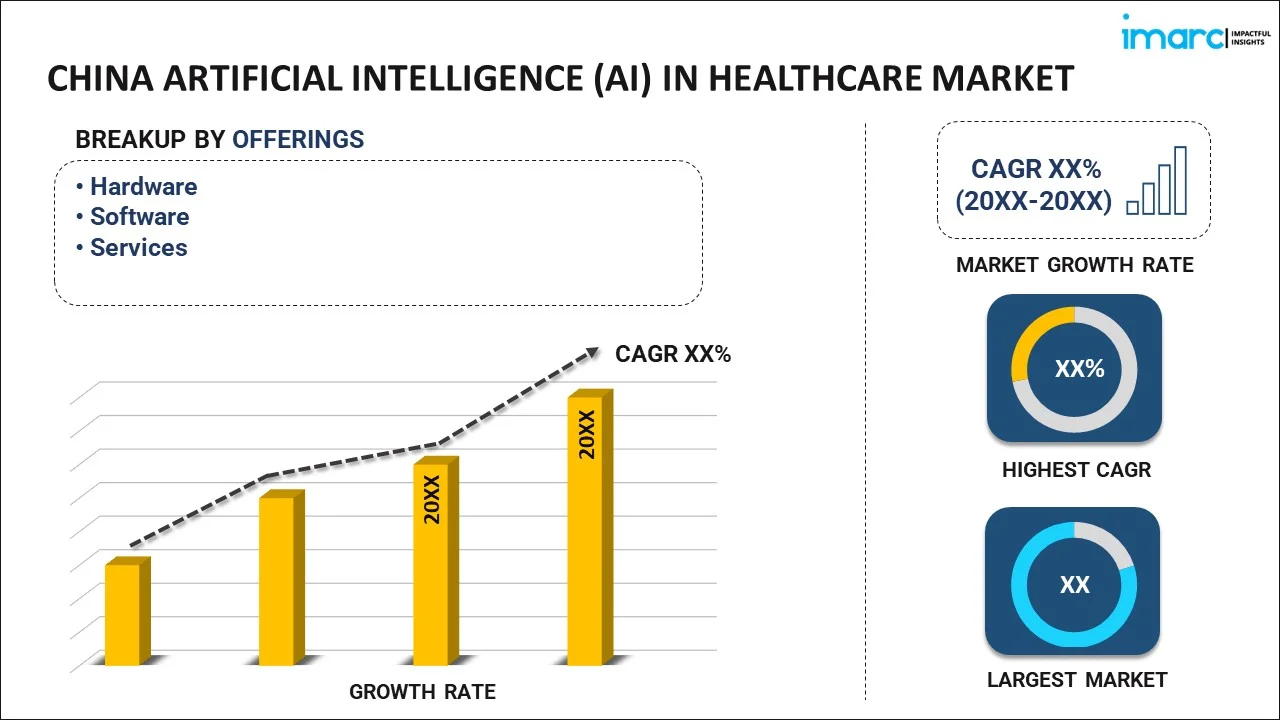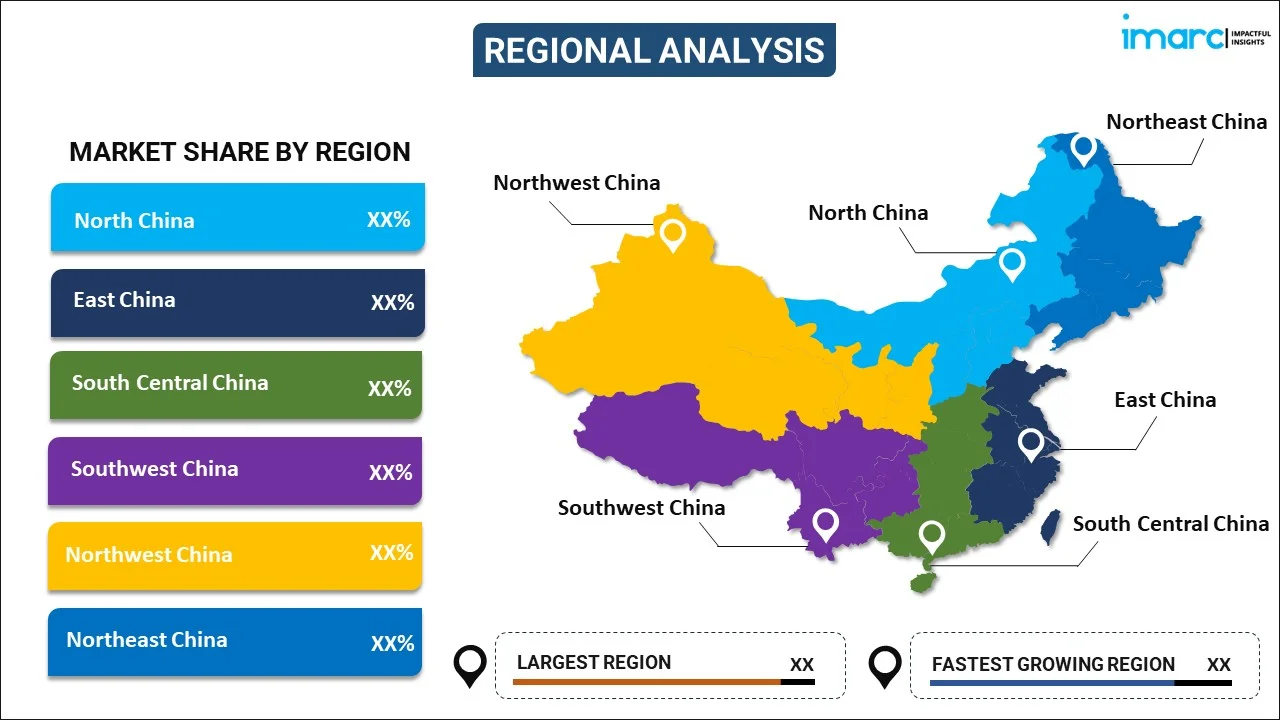
China Artificial Intelligence (AI) In Healthcare Market Report by Offering (Hardware, Software, Services), Technology (Machine Learning, Context-Aware Computin, Natural Language Processing, and Others), Application (Robot-Assisted Surgery, Virtual Nursing Assistant, Administrative Workflow Assistance, Fraud Detection, Dosage Error Reduction, Clinical Trial Participant Identifier, Preliminary Diagnosis, and Others), End User (Healthcare Providers, Pharmaceutical and Biotechnology Companies, Patients, and Others), and Region 2025-2033
China Artificial Intelligence (AI) In Healthcare Market Overview:
The China artificial intelligence (AI) in healthcare market size reached USD 1,285.8 Million in 2024. Looking forward, IMARC Group expects the market to reach USD 8,593.3 Million by 2033, exhibiting a growth rate (CAGR) of 23.50% during 2025-2033. The growing geriatric population in the country, increasing innovations in machine learning (ML), deep learning, and natural language processing (NLP), and rising implementation of favorable government regulations crucial factors impelling the growth of the market.
|
Report Attribute
|
Key Statistics
|
|---|---|
|
Base Year
|
2024
|
|
Forecast Years
|
2025-2033
|
|
Historical Years
|
2019-2024
|
|
Market Size in 2024
|
USD 1,285.8 Million |
|
Market Forecast in 2033
|
USD 8,593.3 Million |
| Market Growth Rate 2025-2033 | 23.50% |
China Artificial Intelligence (AI) In Healthcare Market Trends:
Technological Advancements and Innovation
Rapid advancements of artificial intelligence (AI) technologies are impelling the growth of the market in China. Innovations in machine learning (ML), deep learning, and natural language processing (NLP) are enabling more sophisticated applications in medical diagnostics, treatment planning, and patient management. These technologies enhance the accuracy and efficiency of disease detection, with AI algorithms capable of analyzing vast amounts of medical data more quickly and accurately than human practitioners. For instance, AI systems are now being used to interpret medical imaging, such as X-rays, with high precision, often detecting abnormalities that might be missed by human eyes. This not only improves diagnostic accuracy but also speeds up the diagnostic process, allowing for quicker treatment decisions. As per an article presented by the National Health Executive in 2023, X-Raydar, a novel AI software, was created after conducting a study by the University of Warwick and King’s College London for analyzing X-rays and making accurate diagnoses.
Additionally, AI-driven predictive analytics help in identifying potential health issues before they become critical, facilitating preventive care and early intervention. This technological prowess is fostering a favorable environment for the adoption of AI solutions across various healthcare segments in China, from large hospitals to smaller clinics.
Government Support and Policy Initiatives
The robust support and strategic policy initiatives taken by the government are propelling the market growth. Recognizing AI as a critical component of future healthcare infrastructure, the government is rolling out numerous policies and funding programs to foster AI research and development (R&D). For example, the State Council's "A Next Generation Artificial Intelligence Development Plan" aims to make China a major leader in AI by 2030, with specific emphasis on healthcare applications. This plan includes substantial investments in AI startups and incentives for integrating AI technologies in healthcare institutions.
Rising Healthcare Needs and Aging Population
The rising healthcare demands caused by the aging demographic represent a pivotal force facilitating the integration of AI in the healthcare market. With a substantial segment of the populace stepping into old age, there is an accompanying escalation in chronic illnesses and age-related health complications. This demographic transformation exerts immense pressure on the healthcare infrastructure, necessitating more efficient and effective delivery solutions. AI technologies present promising avenues by optimizing patient care through personalized treatment regimens and streamlined resource management. Furthermore, AI aids in handling vast quantities of patient data, empowering healthcare providers to offer personalized care attuned to individual patient histories and requirements.
Moreover, AI-powered telemedicine platforms are becoming indispensable in offering accessible healthcare services to elderly patients, especially in remote or underserved regions. These platforms enable continuous monitoring and management of chronic conditions, reducing the frequency of hospital visits and alleviating the strain on healthcare facilities.
China Artificial Intelligence (AI) In Healthcare Market News:
- May 2024: Researchers of Tsinghua University developed an AI hospital called “Agent Hospital” where all doctors, nurses, and patients are managed and driven by large language model (LLM)-powered intelligent agents with autonomous interaction capabilities.
- March 2024: China is planning to test an AI assistant for neurosurgeons at 7 hospitals in Beijing and other cities. A Hong Kong based agency under the Chinese Academy of Sciences introduced an AI model dependent on Meta Platform Inc.’s Llama 2.0 researchers.
China Artificial Intelligence (AI) in Healthcare Market Segmentation:
IMARC Group provides an analysis of the key trends in each segment of the market, along with forecasts at the country level for 2025-2033. Our report has categorized the market based on offering, technology, application, and end user.
Offering Insights:

- Hardware
- Software
- Services
The report has provided a detailed breakup and analysis of the market based on the offering. This includes hardware, software, and services.
Technology Insights:
- Machine Learning
- Context-Aware Computing
- Natural Language Processing
- Others
A detailed breakup and analysis of the market based on the technology have also been provided in the report. This includes machine learning, context-aware computing, natural language processing, and others.
Application Insights:
- Robot-Assisted Surgery
- Virtual Nursing Assistant
- Administrative Workflow Assistance
- Fraud Detection
- Dosage Error Reduction
- Clinical Trial Participant Identifier
- Preliminary Diagnosis
- Others
The report has provided a detailed breakup and analysis of the market based on the application. This includes robot-assisted surgery, virtual nursing assistant, administrative workflow assistance, fraud detection, dosage error reduction, clinical trial participant identifier, preliminary diagnosis, and others.
End User Insights:
- Healthcare Providers
- Pharmaceutical and Biotechnology Companies
- Patients
- Others
A detailed breakup and analysis of the market based on the end user have also been provided in the report. This includes healthcare providers, pharmaceutical and biotechnology companies, patients, and others.
Region Insights:

- North China
- East China
- South Central China
- Southwest China
- Northwest China
- Northeast China
The report has also provided a comprehensive analysis of all the major regional markets, which include North China, East China, South Central China, Southwest China, Northwest China, and Northeast China.
Competitive Landscape:
The market research report has also provided a comprehensive analysis of the competitive landscape. Competitive analysis such as market structure, key player positioning, top winning strategies, competitive dashboard, and company evaluation quadrant has been covered in the report. Also, detailed profiles of all major companies have been provided.
China Artificial Intelligence (AI) in Healthcare Market Report Coverage:
| Report Features | Details |
|---|---|
| Base Year of the Analysis | 2024 |
| Historical Period | 2019-2024 |
| Forecast Period | 2025-2033 |
| Units | Million USD |
| Scope of the Report | Exploration of Historical Trends and Market Outlook, Industry Catalysts and Challenges, Segment-Wise Historical and Future Market Assessment:
|
| Offerings Covered | Hardware, Software, Services |
| Technologies Covered | Machine Learning, Context-Aware Computing, Natural Language Processing, Others |
| Applications Covered | Robot-Assisted Surgery, Virtual Nursing Assistant, Administrative Workflow Assistance, Fraud Detection, Dosage Error Reduction, Clinical Trial Participant Identifier, Preliminary Diagnosis, Others |
| End Users Covered | Healthcare Providers, Pharmaceutical and Biotechnology Companies, Patients, Others |
| Regions Covered | North China, East China, South Central China, Southwest China, Northwest China, Northeast China |
| Customization Scope | 10% Free Customization |
| Post-Sale Analyst Support | 10-12 Weeks |
| Delivery Format | PDF and Excel through Email (We can also provide the editable version of the report in PPT/Word format on special request) |
Key Questions Answered in This Report:
- How has the China artificial intelligence (AI) in healthcare market performed so far and how will it perform in the coming years?
- What is the breakup of the China artificial intelligence (AI) in healthcare market on the basis of offering?
- What is the breakup of the China artificial intelligence (AI) in healthcare market on the basis of technology?
- What is the breakup of the China artificial intelligence (AI) in healthcare market on the basis of application?
- What is the breakup of the China artificial intelligence (AI) in healthcare market on the basis of end user?
- What are the various stages in the value chain of the China artificial intelligence (AI) in healthcare market?
- What are the key driving factors and challenges in the China artificial intelligence (AI) in healthcare?
- What is the structure of the China artificial intelligence (AI) in healthcare market and who are the key players?
- What is the degree of competition in the China artificial intelligence (AI) in healthcare market?
Key Benefits for Stakeholders:
- IMARC’s industry report offers a comprehensive quantitative analysis of various market segments, historical and current market trends, market forecasts, and dynamics of the China artificial intelligence (AI) in healthcare market from 2019-2033.
- The research report provides the latest information on the market drivers, challenges, and opportunities in the China artificial intelligence (AI) in healthcare market.
- Porter's five forces analysis assist stakeholders in assessing the impact of new entrants, competitive rivalry, supplier power, buyer power, and the threat of substitution. It helps stakeholders to analyze the level of competition within the China artificial intelligence (AI) in healthcare industry and its attractiveness.
- Competitive landscape allows stakeholders to understand their competitive environment and provides an insight into the current positions of key players in the market.
Need more help?
- Speak to our experienced analysts for insights on the current market scenarios.
- Include additional segments and countries to customize the report as per your requirement.
- Gain an unparalleled competitive advantage in your domain by understanding how to utilize the report and positively impacting your operations and revenue.
- For further assistance, please connect with our analysts.
 Request Customization
Request Customization
 Speak to an Analyst
Speak to an Analyst
 Request Brochure
Request Brochure
 Inquire Before Buying
Inquire Before Buying




.webp)




.webp)












